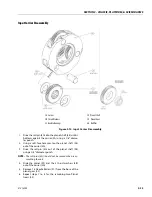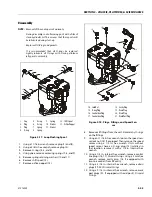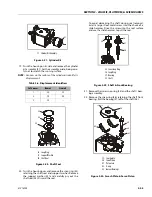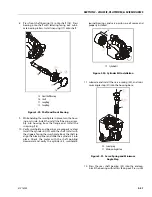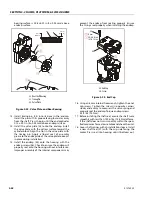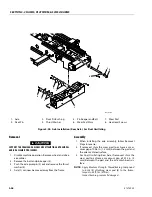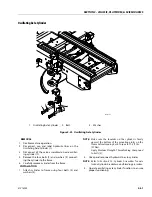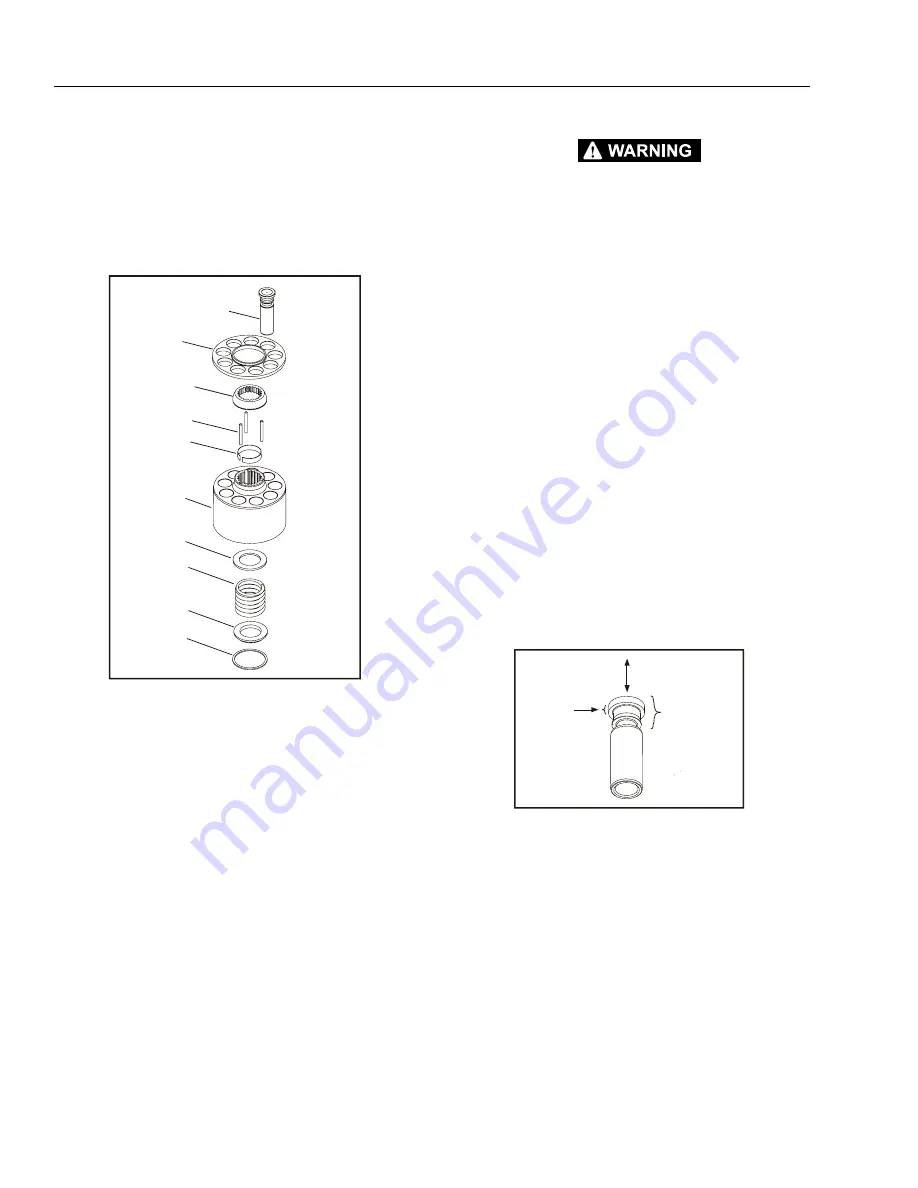
SECTION 3 - CHASSIS, PLATFORM, & SCISSOR ARMS
3-46
31215923
23. Turn housing over and remove the swashplate (39)
by lifting on the end opposite the servo lever.
24. Remove the servo piston (40). Remove the piston
seal (41) and O-ring (42) from the servo piston. Dis-
card the seal and O-ring.
25. Remove the journal bearings (43) from the housing.
If the bearings are to be reused, note the location
and orientation of each bearing for reassembly.
26. Remove pistons (44) and slipper retainer (45) from
the cylinder block (46).
The pistons are not selectively fitted, however units
with high hourly usage may develop wear patterns.
Number the pistons and bores for reassembly if they
are to be reused.
27. Remove the ball guide (47), hold-down pins (48), and
retaining ring (49) from the cylinder block.
NOTE:
Most repairs do not require block spring removal.
Perform this procedure only if you suspect problems
with the block spring.
RISK OF PERSONAL INJURY: COMPRESSING THE BLOCK SPRING
REQUIRES FORCE OF ABOUT 80 TO 90 LBF (350 TO 400 N). USE A
PRESS SUFFICIENT TO MAINTAIN THIS FORCE WITH REASONABLE
EFFORT. ENSURE THE SPRING IS SECURE BEFORE ATTEMPTING TO
REMOVE THE SPIRAL RETAINING RING. RELEASE THE PRESSURE
SLOWLY AFTER THE RETAINING RING IS REMOVED.
28. Turn the block over. Using a press, apply pressure on
the block spring washer (50) to compress the block
spring. Compress the spring enough to safely
remove the spiral retaining ring (51). While maintain-
ing pressure, unwind the spiral retaining ring (51).
Carefully release the pressure and remove the outer
block spring washer (50), block spring (52), and inner
block spring washer (53) from the cylinder block.
Inspection
After disassembly, wash all parts (including the end-cap
and housing) thoroughly with clean solvent and allow
to air dry. Blow out oil passages in the housing and end-
cap with compressed air. Conduct inspection in a clean
area and keep all parts free from contamination. Clean
and dry parts again after any rework or resurfacing.
PISTON
Inspect the pistons for damage and discoloration. Dis-
colored pistons may indicate excessive heat; do not
reuse.
SLIPPERS
Inspect the running surface of the slippers. Replace any
piston assemblies with scored or excessively rounded
slipper edges. Measure the slipper foot thickness.
Replace any piston assemblies with excessively worn
slippers. Check the slipper axial end-play. Replace any
piston assemblies with excessive end-play.
Minimum slipper foot thickness and maximum axial
end-play are given in the table below.
CYLINDER BLOCK
Measure the cylinder block height. Replace blocks worn
beyond the minimum height specification. Inspect the
running surface of the cylinder block. Replace or resur-
face worn or scratched blocks. Blocks may be resurfaced
51
50
52
53
46
49
48
47
45
44
44. Piston
45. Slipper Retainer
46. Cylinder Block
47. Ball Guide
48. Holddown Pins
49. Retaining Ring
50. Block Spring Washer
51. Spiral Retaining Ring
52. Block Spring
53. Inner Block Spring Washer
Figure 3-25. Cylinder Kit Disassembly
Slipper
Maximum end play
M inimum
slipper fo ot
thick ness
Summary of Contents for ERT2669
Page 2: ......
Page 4: ...INTRODUCTION A 2 31215923 REVISON LOG Original Issue A January 08 2021...
Page 12: ...viii 31215923 TABLE OF CONTENTS...
Page 40: ...SECTION 1 SPECIFICATIONS 1 22 31215923...
Page 58: ...SECTION 2 GENERAL 2 18 31215923...
Page 187: ...SECTION 4 BASIC HYDRAULIC INFORMATION SCHEMATICS 31215923 4 11...
Page 206: ...SECTION 4 BASIC HYDRAULIC INFORMATION SCHEMATICS 4 30 31215923...
Page 225: ...SECTION 4 BASIC HYDRAULIC INFORMATION SCHEMATICS 31215923 4 49...
Page 242: ...SECTION 4 BASIC HYDRAULIC INFORMATION SCHEMATICS 4 66 31215923...
Page 307: ...SECTION 5 JLG CONTROL SYSTEM 31215923 5 65...
Page 334: ...SECTION 6 LSS SETUP CALIBRATION SERVICE 6 12 31215923...
Page 362: ...SECTION 7 GENERAL ELECTRICAL INFORMATION SCHEMATICS 7 28 31215923...
Page 374: ...SECTION 7 GENERAL ELECTRICAL INFORMATION SCHEMATICS 7 40 31215923...
Page 375: ......


